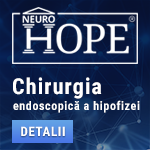 |
Chirurgia endoscopică a hipofizei
"Standardul de aur" în chirurgia hipofizară îl reprezintă endoscopia transnazală transsfenoidală. Echipa NeuroHope este antrenată în unul din cele mai mari centre de chirurgie a hipofizei din Europa, Spitalul Foch din Paris, centrul în care a fost introdus pentru prima dată endoscopul în chirurgia transnazală a hipofizei, de către neurochirurgul francez Guiot. Pe lângă tumorile cu origine hipofizară, prin tehnicile endoscopice transnazale pot fi abordate numeroase alte patologii neurochirurgicale. www.neurohope.ro |
Pisica in greva foamei!
Last Updated: Jul 06 2012 05:05, Started by
regali
, Jul 02 2012 21:08
·
 0
0
#37
 Posted 05 July 2012 - 13:59
Posted 05 July 2012 - 13:59

|
Hai sa incercam s apastram un ton civilizat aici.. Realitatea, din ce vad in jurul meu, e ca multe persoane care au pisici considera pana si hrana uscata gen Wiskas un moft scump si cauta hrana vrac mai ieftina sau, majoritatea, hranesc pisica cu resturi din ce mananca ei - ii arunca o coaja de paine, o bucata de salam si niste lapte rece - asta incercam eu sa combat (cine isi permite macar sa cumpere hrana premium de calitate mai buna). Mentalitatea asta ca orice rest e bun vine de la tara, unde multi isi hranesc cainele cu doua coji de paine pe saptamana iar pisica niciodata (noroc ca acolo pisica mai reuseste sa vaneze ceva). Normal, cine are timp si gateste acasa zilnic, merita sa incerce sa pregateasca un meniu special pentru pisica, insa pentru multi care de-abia apuca sa treaca pe acasa 1 ora dimineata si una seara, si nu isi prepara nici un ceai acasa pentru ei insisi (si stiu multe persoane la oras care duc o astfel de viata), e nerealist, din pacate. nu trebuie sa i gateasca,doar sa-i taie o bucata de carne cu cutitu si sa i-o arunce pisicului,atat..nimic mai mult ce tot vorbesti atata de gatit? Edited by bilibistrocizel, 05 July 2012 - 14:01. |
#38
 Posted 06 July 2012 - 04:54
Posted 06 July 2012 - 04:54

|
pot sa pun pariu ca aia 44% carne, nu e macra; e maxim mdm, adica resturi Quote Whatever remains of the carcass — heads, feet, bones, blood, intestines, lungs, spleens, livers, ligaments, fat trimmings, unborn babies, and other parts not generally consumed by humans — is used in pet food, animal feed, fertilizer, industrial lubricants, soap, rubber, and other products. These “other parts” are known as “by-products.” By-products are used in feed for poultry and livestock as well as in pet food. Quote The better brands of pet food, such as many “super-premium,” “natural,” and “organic” varieties, do not use by-products. On the label, you'll see one or more named meats among the first few ingredients, such as “turkey” or “lamb.” These meats are still mainly leftover scraps; in the case of poultry, bones are allowed, so “chicken” consists mainly of backs and frames—the spine and ribs, minus their expensive breast meat. The small amount of meat left on the bones is the meat in the pet food. Even with this less-attractive source, pet food marketers are very tricky when talking about meat, so this is explained further in the section on “Marketing Magic” below. Quote Unfortunately this is far from the truth, More than 95% of pets derive their nutritional needs from a single source, processed pet foods. When people think of pet food many envision whole chicken meat, choice cuts of beef, fresh grains and all the nutrition that their dog or cat would ever need, images that pet food manufacturers promote in their advertisements and print on their food bags. What these companies do not reveal is that instead of wholesome chicken meat, they have substituted chicken heads, feet, feathers and intestines. Those choice cuts of beef are really cow brains, tongues, esophagi, fetal tissue dangerously high in hormones and even diseased and cancerous meat. Those whole grains have had the starch removed for corn starch powder and the oil extracted for corn oil or they are just hulls and other remnants from the milling process. Grains used that are truly whole have usually been deemed unfit for human consumption because of mold, contaminants, poor quality or poor handling practices, which is obvious by the fact that most pet food recalls are the result of toxic grain products such as Corn or Wheat. Pet food is one of worlds most synthetic edible products, containing virtually no whole ingredients.
asta incercam eu sa combat (cine isi permite macar sa cumpere hrana premium de calitate mai buna). |
#39
 Posted 06 July 2012 - 05:05
Posted 06 July 2012 - 05:05

Anunturi
▶ 0 user(s) are reading this topic
0 members, 0 guests, 0 anonymous users
 Sign In
Sign In Create Account
Create Account


 Back to top
Back to top
